Our Heritage
Catholicism in America extends back 379 years. In 1634, the Reverend Andrew White and a small band of followers stepped onto Maryland soil from the vessel, The Arc and the Dove, in St. Mary’s County. One hundred and fifty years later, the Bishop of Baltimore presided over a diocese that stretched from the Atlantic Ocean to the Mississippi River. Eighty years after that, train riding priests from the Shenandoah Valley established a “mission” in Charlottesville. That was the beginning of Holy Comforter Catholic Church.
The first Mass of record in Charlottesville was celebrated in the parlor of F. M. Paoli’s residence, presumably on Random Row, now West Main Street. Services were held for about 12 years after that in the Town Hall. The presiders were priests who came from St. Francis Assisi Church in Staunton and then traveled on to other missions in the area.

The Church of the Paraclete
The first Catholic Church in Charlottesville, the Church of the Paraclete, was erected in 1880 on the corner of Jefferson Street and School Street (now 3rd Street, Northeast). The principal contributor was Martin Tracy who donated a 75-acre farm to the church. The parcel sold for $1,300 and provided the funding necessary to build the church. The cornerstone was laid on July 25,1880, by the Most Reverend John J. Keane, Bishop of Richmond. The building was described as “a pretty brick structure, 35 by 60 feet, with a tower on the northeast corner.” Priests initially continued to come once or twice a month from Staunton to say Mass. The first resident pastor, the Reverend John Massey, was appointed in 1896.
The church became Holy Comforter Catholic Church early in the 20th Century. The original building was renovated and enlarged, and a rectory was added adjacent to the church. A 1906 report from The Daily Progress described Holy Comforter as “an ornament to the city.” An enchanting courtyard with trees, shrubbery and a small fountain was created between the church and the rectory. Parishioners gathered there for picnics and other socials for which the women of the parish baked cakes, froze ice cream and strung Japanese lanterns among the trees. The Benedictine Sisters from Bristow conducted Vacation School with the help of parishioners who, among other things, supervised recreation in Lee Park. The pastor taught Saturday morning catechism classes in the rectory with the help of lay teachers and, on one Sunday a month until 1913, traveled to missions as far away as Culpepper, Gordonsville and Orange County.
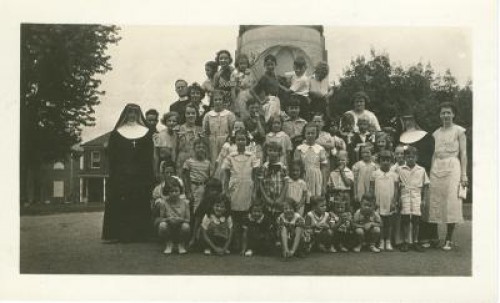
Mr. and Mrs.Thomas Fortune Ryan, of New York and Oak Ridge in Nelson County, donated $30,000 in 1919 to enlarge and modernize the church and provide a suitable rectory. The Ryans were incredibly generous throughout Virginia and also financed the building of the Cathedral of the Sacred Heart in Richmond. The old edifice of Holy Comforter was demolished in 1924, and construction began on its replacement early the following year. The architect for the new building, S. J. Makielski, AIA, was an assistant professor of art and architecture at the University of Virginia. The notable Sant’ Andrea in Mantua, Italy, an early Renaissance church designed by Leon Battista Alberti, was an inspiration for the new edifice. The architect’s brother, B. A. Makielski, painted the Christ motif that adorns the sanctuary today. The high altar, imported from Italy, was donated by the Catholic Daughters. Two side altars were purchased with a $10,000 bequest from John Conlon, a bachelor tailor. One of the side altars now serves as our main altar, and the other was reconfigured into the ambo. Services were held during the construction period on the second floor of a bank building at Fourth and Main Streets where Miller and Rhoads Department Store and S & L Securities were later located The building just west of the church was purchased in 1925 to serve as the rectory. The new church was dedicated in May of the same year.
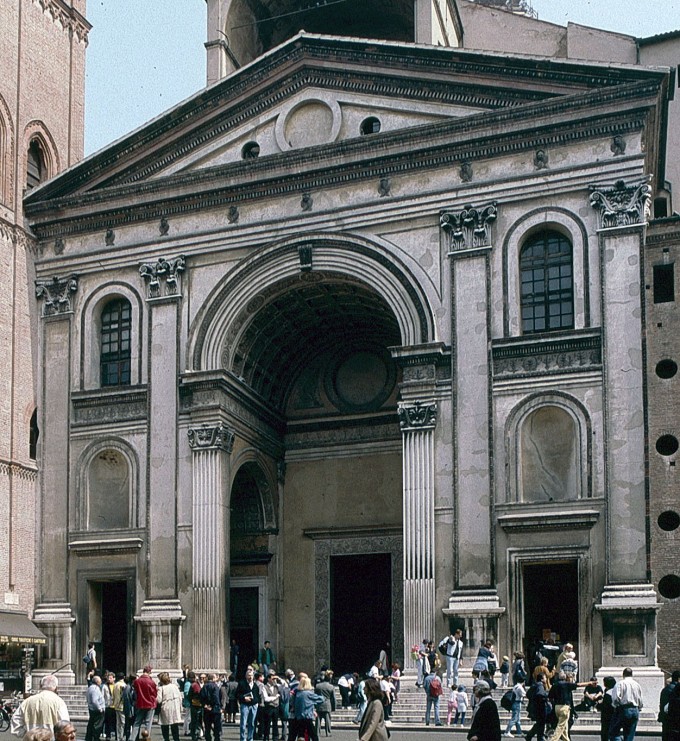
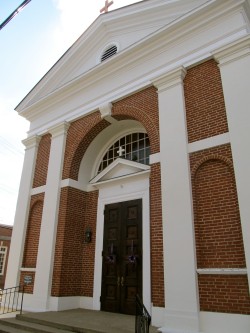

The ties between the downtown church and the University of Virginia were substantial by the 1930′s. Holy Comforter had more than 250 parishioners, and many of these were University students and professors. The parish music director, H. R. Pratt, taught music at the University. Professor Pratt and the pastor, the Reverend John J. Brochtrup, wanted to make Holy Comforter a musical showplace. Father Brochtrup, ignoring the constraints of the Depression and insisting that good music would only enhance the church’s relationship with the University, persuaded the Bishop, Andrew J. Brennan, to purchase a new organ for the church. The Austin organ was installed by April, 1932, and is still in use.
The Newman Club for Catholic students was established at the University of Virginia in 1947 under the direction of the Reverend Francis J. Blakely, pastor of Holy Comforter. Father Blakely, welcoming students that year, said, “We are confident our efforts to enrich the students spiritually, intellectually and socially will not be in vain.” The Newman Club developed into the Catholic Center for the University in 1959 and, in 1963, became and was dedicated as St. Thomas Aquinas Catholic Church.
The diocese purchased a small Christian chapel on the corner of Concord Avenue and Foster Street in the early 1950′s. The cinder block and clapboard building had been condemned by the city as soon as it was built. The structure was renovated as a Catholic chapel under the guidance of the Holy Comforter pastor, the Reverend Raymond Schantz, and became St. Margaret Mary Church, the worship center for black Catholics in Charlottesville.
Bishop John Russell in the late 1960s sought to integrate Catholic parishes in the Richmond Diocese. To that end, he opted to close the black-only parishes. Upon St. Margaret Mary’s shuttering, its members joined Holy Comforter in 1968. The chapel property was converted into low-cost apartments by the Holy Comforter Low-Cost Housing Corporation. The first tenants took occupancy in the St. Margaret Mary Apartments in 1970.
Formal Catholic education began at Holy Comforter in 1951 under the direction of the pastor, the Reverend J. Bernard Moore. A kindergarten, staffed by two Adrian Dominican sisters, was opened in the old Wilson estate, at 416 Park Street. In 1953, property known as “The Chimney,” located where Berkeley Subdivision is now, was purchased for $25,000 and became the parish school. The following year “Branchlands,” an estate on 29 North, was acquired for $78,000, and school sessions were held there in the “big white house.” A crusade to reduce the church’s debt was so successful that, in 1960, the Holy Comforter School at Branchlands was dedicated, and the Holy Comforter Chapel, at the same location, was opened. The school remained in operation for 10 years and was the inspiration for the present Charlottesville Catholic School.
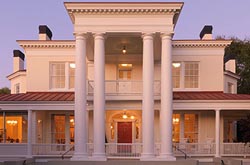
Both the Chapel at Branchlands and the downtown church grew, and, in 1976, the “Branchlands Catholic community,” now the Church of the Incarnation, came into being. Some Holy Comforter parishioners–about 275 in all–committed to staying with the downtown church.
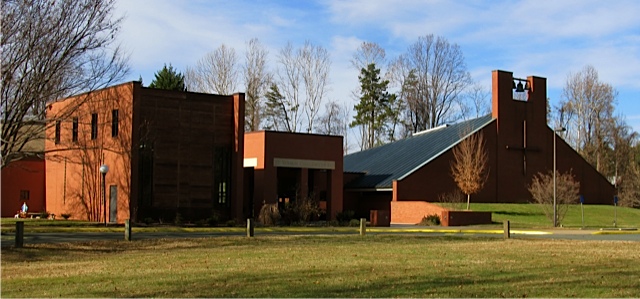
Holy Comforter continued to grow. A centennial committee was appointed in 1978 to shape a renovation and building plan for the parish. The parishioners were committed to both the church’s downtown location and to the mission of serving the parish community and the needs of a growing social ministry. A subcommittee, charged with looking into that social ministry, drafted a “commitment to the community,” which stated in part, “… the complex of buildings should speak of our concerns for our immediate downtown community and to the total world community.” A parish mission statement emerged from the centennial committee that committed the church to outreach through social ministry for the elderly and a soup kitchen for the poor and needy. The parishioners developed plans to renovate and enlarge the present facility to better serve those ends. The $1 million sale of 70 acres at Branchlands provided funds for both the Holy Comforter expansion project and the construction of a new church building for the sister parish, Church of the Incarnation. A contribution of $40,000 by parishioner Estelle Burthe provided for the purchase of a new rectory on Evergreen Street. The old rectory adjacent to the church was demolished, and an addition, almost as large as the main church, was constructed. Jack Reinhart, a local University of Virginia graduate and architect, designed the new space. Services were held during the building process at First Methodist Church and at Christ Episcopal Church. Temple Beth Israel provided space for both religious education and offices for Holy Comforter’s social ministry.
The expansion project at Holy Comforter was completed in 1982. The parishioners recommitted in 1990, eight years later, to the church’s urban location and mission, and they continued to press for expansion in celebration of the church’s 110th anniversary. The renovation, they said, “still left us with a space shortage which has continued to grow as the parish grows.” That same year, the parish commissioned a local architect, Bruce R. Wardell, to do a spatial needs study for Holy Comforter. Several renovation and expansion options were considered but not acted upon.
Again, in 2006, the church’s space needs were addressed, and a capital campaign was launched, focusing upon the renovation of existing facilities and the construction or purchase of additional space. Parishioners generously pledged $1.1 million. Eventually, cost overruns and problems uncovered by structural engineering studies made building a prohibitive option. The possibility of purchasing property near the church was explored, but there were no available sites that met the needs of the parish. Overdue repair and renovation work on the existing structure was accomplished; a capital maintenance fund was established; and a sizable donation was made to our sister parish, St. Michel Saltadere, in Haiti. Parishioners who contributed to the campaign were given three options: the unused portion of their gift could be returned to them; it could be given to a charity of their choice; or it could be retained by the church for the purpose of meeting future church and ministry needs. The rectory on Evergreen Street was sold and replaced by a smaller townhouse.
In 2017, the pastor, Fr. Joseph Mary, began to conceptualize a project aimed at renewing the parish as it approached its 140th anniversary, and the Richmond Diocese prepared to celebrate its 200th year. This initiative, dubbed “Holy Comforter 2020” kicked off in earnest late that year with plans to restore the sanctuary. That effort was completed the following year.
The goal of the “Holy Comforter 2020” initiative is to deepen the faith of our parish and lay the foundation for future generations by physically enhancing our church, intensifying our spiritual practice and becoming more connected with one another through social activities. After soliciting ideas from the congregation over a period of several months, the pastor, staff, the pastoral council and the heads of the parish’s various ministries worked together during a retreat to come up with concrete ways to accomplish this mission.
Through this initiative, Holy Comforter has its eyes on thoroughly renew itself aesthetically, spiritually and socially as it approaches a major milestone in our, and our Diocese’s, long and storied history.
Following is a video about the history of the Diocese of Richmond:
LINKS
Holy Comforter featured in The Catholic Virginian (September 30, 2013)